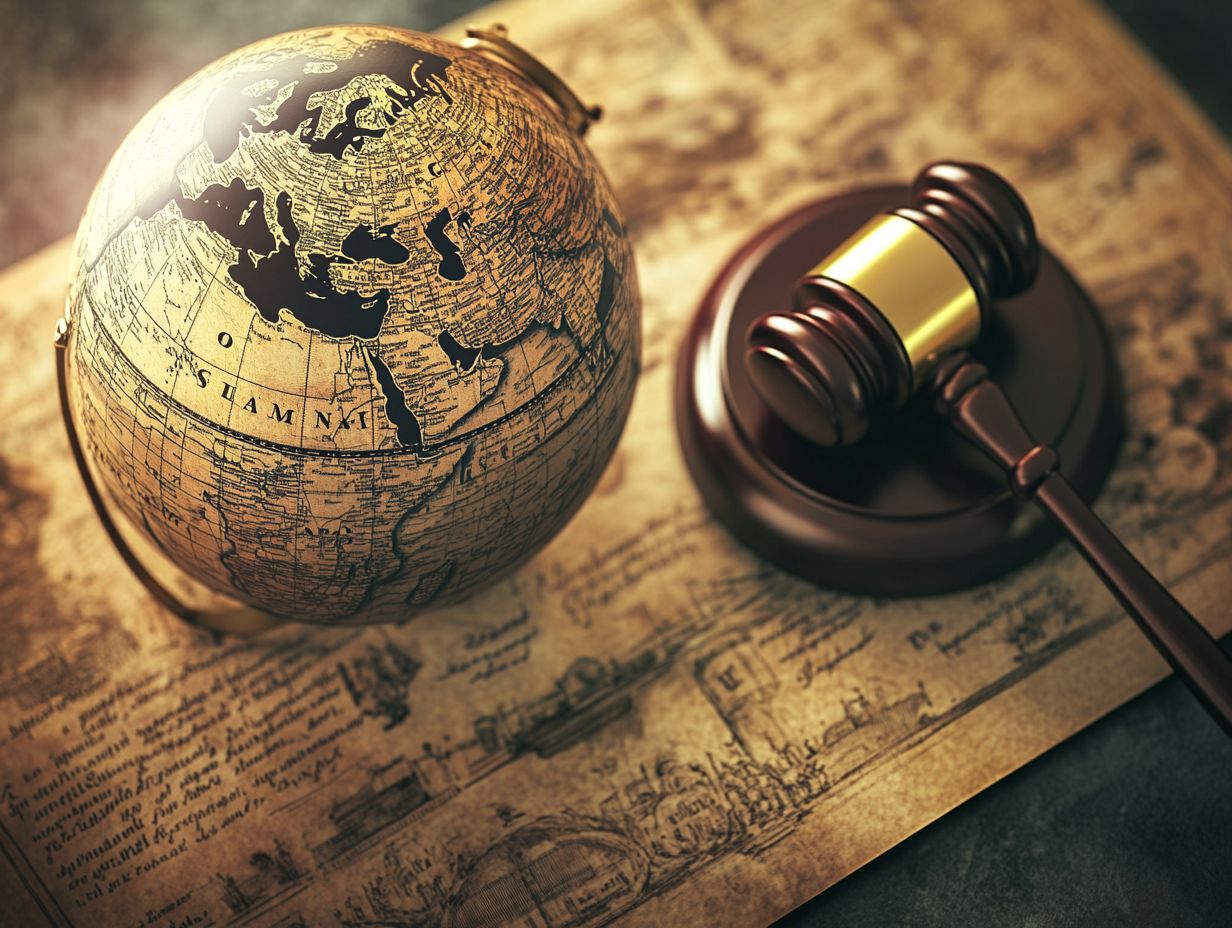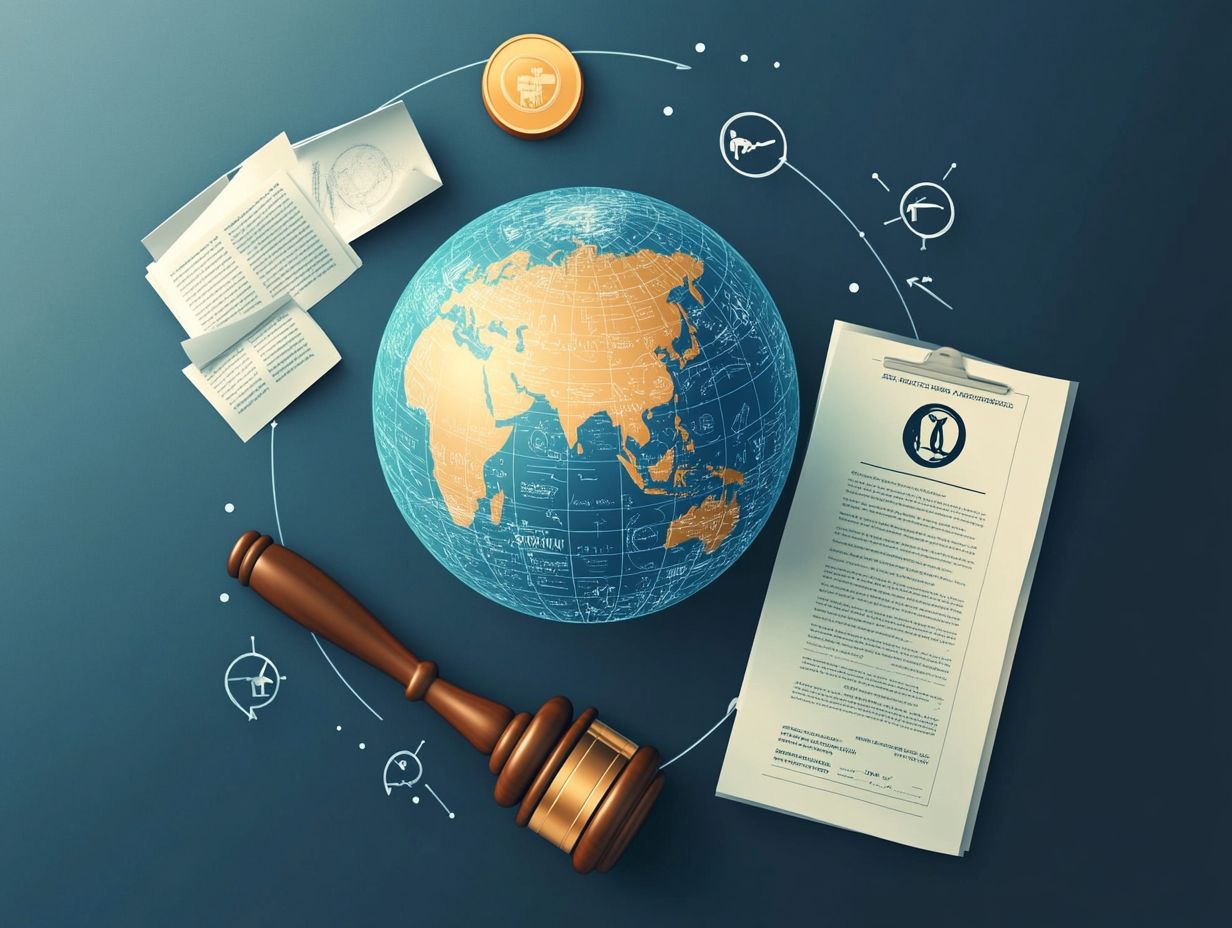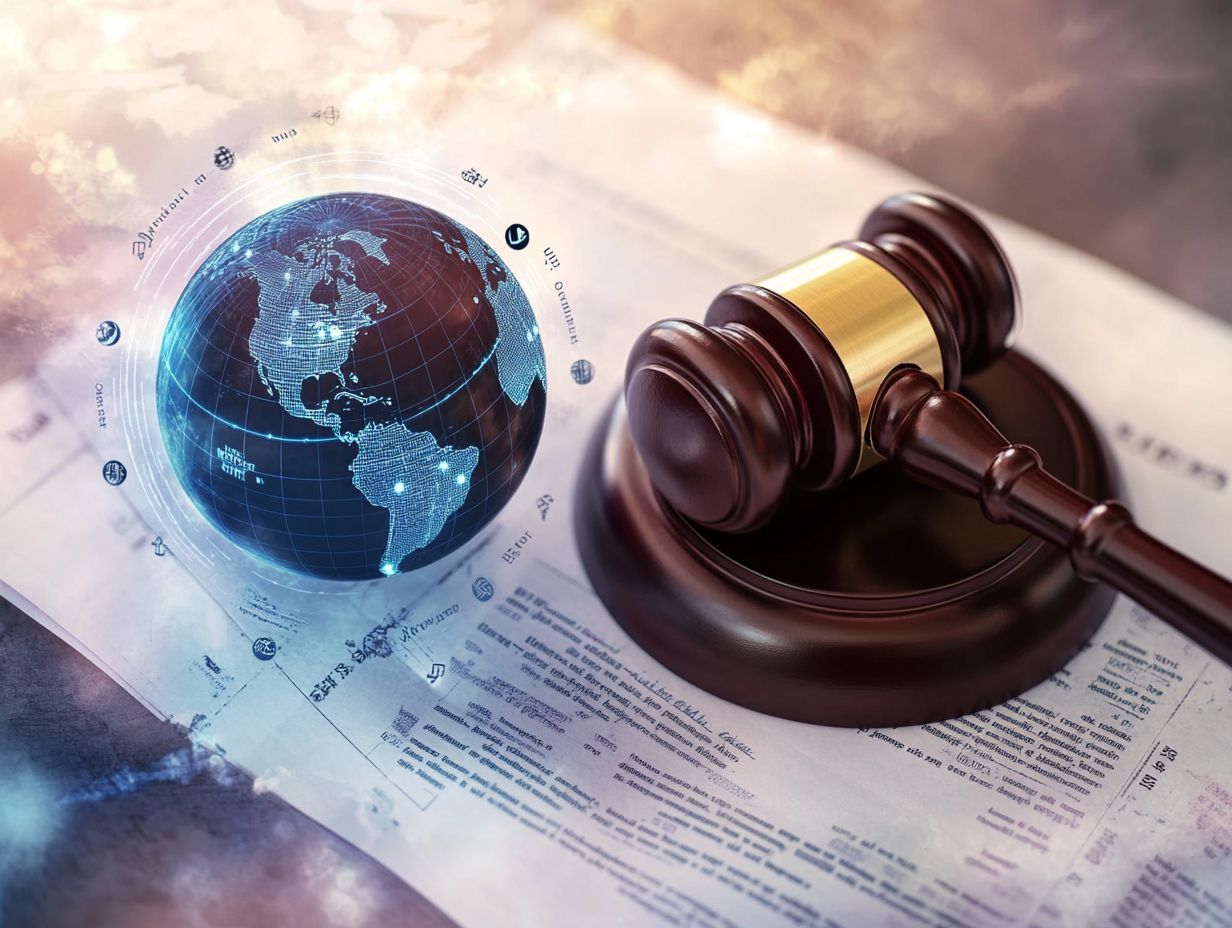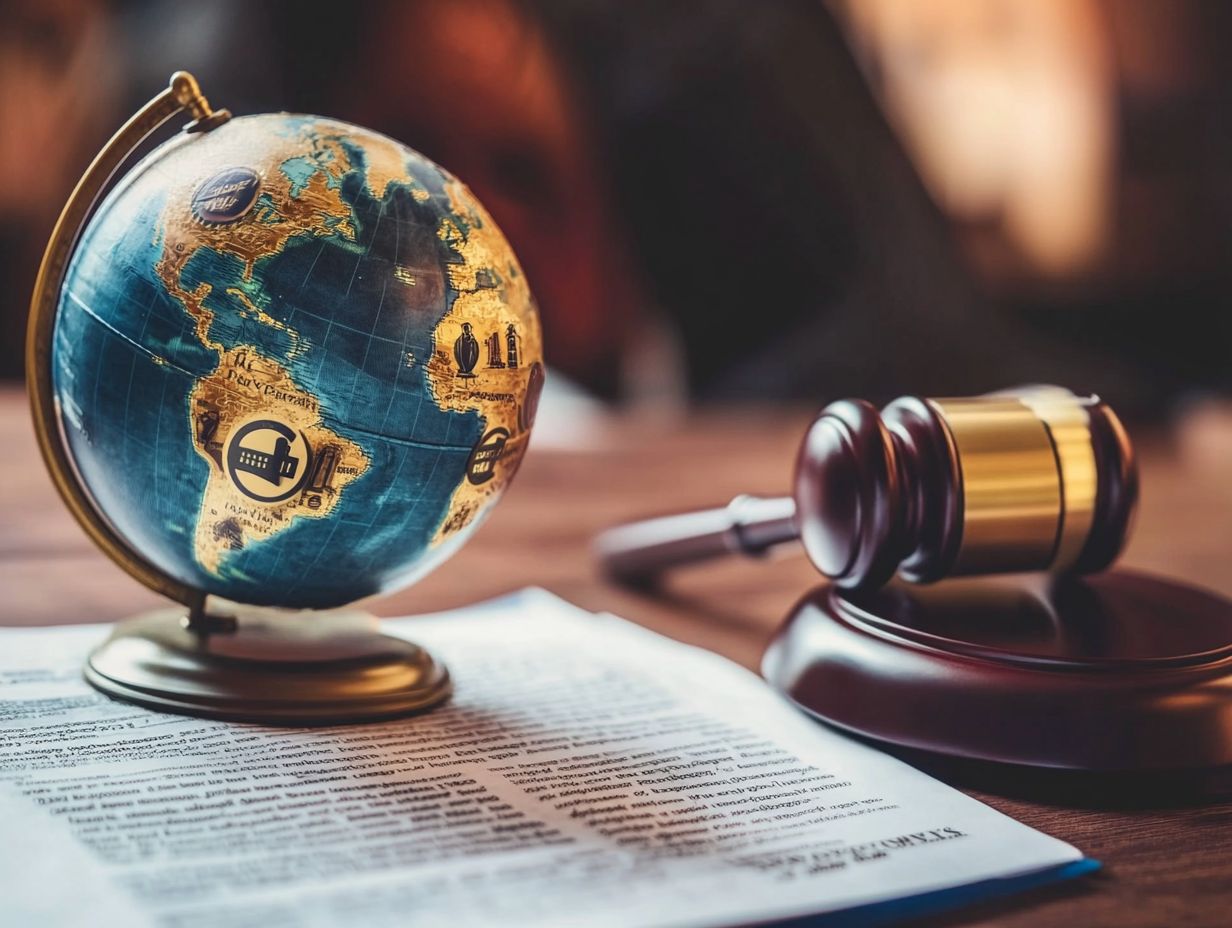How International Laws Affect Trademarks
In today s global marketplace, understanding the nuances of international trademark laws is crucial for business owners wanting to safeguard their brand identity.
This article simplifies the complexities of trademark protection across borders. It outlines essential concepts and terminology while addressing the influence of international treaties and agreements.
You will explore the challenges of enforcing trademark rights, navigating various legal systems, and the registration processes in different countries.
Discover effective strategies to protect your trademark globally!
Join us as we unravel the intricate web of international trademark laws for you!
Contents
- Key Takeaways:
- Overview of International Trademark Laws
- International Treaties and Agreements
- Enforcing Trademark Rights Internationally
- Navigating Different Legal Systems
- Trademark Registration Process in Different Countries
- Protecting Your Trademark Globally
- Frequently Asked Questions
- What are international laws and how do they affect trademarks?
- Why are international laws important for trademarks?
- How do international laws impact trademark registration?
- Can international laws help protect my trademark from infringement?
- Do international laws apply to all countries?
- What happens if a country does not comply with international laws for trademarks?
Key Takeaways:

- International trademark laws protect the rights of trademark owners globally, but the scope and enforcement vary by country.
- You must understand and navigate different legal systems to enforce your trademark rights internationally since local laws and regulations differ.
- Registering your trademark in various countries requires thorough research and adherence to specific requirements and procedures in each jurisdiction.
Overview of International Trademark Laws
International trademark laws serve as essential frameworks that govern the protection and enforcement of trademark rights across jurisdictions.
These laws depend on treaties and systems, notably the Madrid System, which simplifies international registration, and the Paris Convention, which establishes crucial standards for trademark protection.
These regulations influence branding strategies and empower trademark owners to assert their rights against infringement and counterfeiting, fostering substantial business growth.
For trademark applicants, understanding these laws is vital for navigating the intricacies of global trademark registration and compliance.
Key Concepts and Terminology
Understanding key concepts and terminology related to trademarks is essential for navigating the complex landscape of intellectual property. Familiarity with terms like trademark rights, application filing, and trademark application forms lays the groundwork for effective trademark protection.
Knowledge of licensing agreements and enforcement mechanisms is crucial for maintaining trademark rights against challenges like consumer confusion and infringement.
Trademark rights are the legal rights that allow you to exclusively use your brand name or logo, preventing others from profiting off your reputation. The application filing process is pivotal; it requires you to submit detailed documentation to showcase the distinctiveness of your mark.
To further safeguard your rights, licensing agreements allow you to grant others permission to use your marks under specific conditions. This not only creates new revenue streams but also ensures consistent quality, as major brands like Coca-Cola illustrate.
Enforcement mechanisms, such as cease-and-desist letters, are equally important; they deter infringers by outlining the legal consequences of unauthorized use, thereby securing your brand’s integrity and market position.
International Treaties and Agreements
International treaties and agreements, like the Madrid System and the Paris Convention, are essential for harmonizing trademark protection across countries. They create standardized legal safeguards that you can leverage to expand your geographical reach.
These agreements establish frameworks for international registration and provide registration benefits that simplify the enforcement of trademark rights across jurisdictions. As a result, they significantly enhance the effectiveness of your trademark strategies in the global marketplace.
Impact on Trademark Protection
The impact of international treaties and agreements on trademark protection is significant. They provide clear guidelines to navigate the complexities of trademark laws across various jurisdictions.
By utilizing systems like the Madrid System, which helps you register your trademark in many countries with one application, these treaties streamline your application process. They also bolster the enforcement of your trademark rights, significantly reducing the risks of counterfeiting and infringement.
In today s global economy, act now to protect your brand across diverse markets. This ensures that your identity remains shielded from infringement. The Madrid System simplifies your registration process, enabling you to file a single application that extends coverage to multiple countries, saving you valuable time and resources.
International agreements aim to balance the rights and responsibilities of trademark owners. This fosters a fair environment for resolving disputes and reducing consumer confusion. With a structured approach to conflict resolution, you fortify your trademark protection, allowing consumers to trust the brands they encounter.
Enforcing Trademark Rights Internationally

Enforcing trademark rights on an international scale presents unique challenges. As a trademark owner, it s essential to understand the various enforcement mechanisms and the legal landscape across different jurisdictions.
Effective enforcement is crucial to combating trademark infringement and counterfeiting issues. This requires a solid grasp of international treaties, local laws, and the legal action taken to protect your trademark.
Mastering these elements is vital for ensuring robust trademark protection and securing your legal recourse.
Challenges and Solutions
Navigating the challenges of enforcing trademark rights internationally can feel like traversing a complex labyrinth. You ll encounter variations in laws, the intricacies of disputes, and differing legal standings across regions.
To tackle these challenges effectively, you need strategic planning and the right mechanisms to combat infringement. As a trademark owner, you’ll often maneuver through a maze of regulations that vary significantly from one country to another, complicating your ability to establish a consistent enforcement strategy.
This inconsistency can create substantial legal hurdles and drive up costs, especially in jurisdictions with less developed intellectual property laws. Taking proactive measures, such as conducting thorough due diligence before entering new markets or leveraging international treaties like the Madrid Protocol, can significantly reduce these risks.
Build strong relationships with local legal professionals who understand regional practices. This can streamline your enforcement process and enhance your trademark protection efforts.
Navigating the complexities of various legal systems is vital for trademark applicants in pursuit of robust protection.
The nuances in jurisdiction and trademark laws can profoundly influence both the registration process and the enforcement of your rights.
By grasping local laws and cultural subtleties, you can fulfill application requirements more effectively. This allows you to craft a successful trademark strategy that aligns with regional practices.
Understanding Local Laws and Regulations
Understanding local laws and regulations is crucial for you as a trademark applicant. These legal frameworks dictate application requirements and enforcement procedures in your specific jurisdiction.
Knowing trademark laws can greatly improve your chances of success. Familiarity with the protections they provide can significantly boost your chances of successful trademark registration and effective enforcement of your trademark rights.
The landscape of trademark law varies widely across regions. This variation influences factors such as the duration of the application process, the need for evidence of distinctiveness, and the potential for opposition from third parties.
For example, certain jurisdictions might require proof that the trademark is being used prior to registration, while others might offer a grace period. These intricacies compel you to not only grasp the criteria and processes relevant to your target markets but also to strategically approach the branding and marking of your goods.
A well-informed applicant like you can adapt their strategy to navigate these complexities and leverage local protections. This will fortify your brand against potential infringements.
Trademark Registration Process in Different Countries
The trademark registration process can vary greatly from one country to another. Each jurisdiction establishes its own application filing protocols and classification systems.
Grasping these differences is vital for you. It will help you navigate the intricacies of the registration process and secure effective trademark protection in your desired markets.
Requirements and Procedures

The requirements and procedures for trademark registration can vary significantly by jurisdiction. It’s essential for you to familiarize yourself with these requirements, including trademark classification and the relevant laws, if you aim to file successful applications and effectively secure your rights.
In many jurisdictions, specific documentation is needed. This includes a clear representation of the trademark, a list of goods or services linked to the mark, and proof of its use in commerce.
For instance, in the United States, the USPTO utilizes the Nice Classification system, which categorizes goods and services for trademark applications. You must specify which classes your trademark falls under.
If you want to register in the European Union, you must adhere to Directive 2015/2436. This directive outlines additional procedural steps, including submitting a trademark application form and paying the necessary fees.
By understanding these nuances, you can streamline your application process and significantly enhance your chances of successful registration.
Protecting Your Trademark Globally
Protecting your trademark on a global scale requires a thorough understanding of trademark rights and the diverse strategies available for effective international protection.
By leveraging international treaties and administrative efficiencies, you can significantly bolster your ability to safeguard your branding strategy. This proactive approach enhances your trademark s security and minimizes risks associated with infringement and counterfeiting challenges.
Strategies for Maintaining Trademark Rights
Strategies for maintaining trademark rights are essential for safeguarding your brand against infringement and ensuring compliance with trademark laws. By implementing effective enforcement mechanisms and establishing licensing agreements, you can significantly enhance your ability to manage consumer confusion.
To further solidify these rights, regularly monitor your brand’s use in the marketplace. This proactive approach enables early detection of any unauthorized use or dilution. Educating your employees and partners about the importance of the trademark fosters a culture of brand protection.
Clear and comprehensive licensing agreements help delineate usage rights, preventing misunderstandings. When disputes arise, employing alternative dispute resolution methods like mediation or arbitration can save you valuable time and resources.
Ultimately, these strategies not only protect your brand but also reinforce trust and recognition among your consumers.
Frequently Asked Questions
What are international laws and how do they affect trademarks?
International laws are agreements and regulations enforced between countries. They help protect your rights to your creations, including trademarks, worldwide.
Why are international laws important for trademarks?

International laws protect trademarks by setting standards for registration, use, and enforcement. For detailed insights on how to protect your trademark internationally, these laws also help resolve disputes between trademark owners across borders.
How do international laws impact trademark registration?
International laws like the Paris Convention and the Madrid System streamline trademark registration in multiple countries. This helps brand owners protect their trademark globally.
Can international laws help protect my trademark from infringement?
Yes, these laws enforce trademark rights and defend against infringement. The World Intellectual Property Organization (WIPO) offers services like mediation and arbitration to resolve disputes.
Do international laws apply to all countries?
Most countries have their own trademark laws and have signed international agreements. So, international laws can often protect trademarks across borders.
What happens if a country does not comply with international laws for trademarks?
If a country does not comply, the trademark owner can file a complaint with WIPO or take legal action where the infringement occurred.






